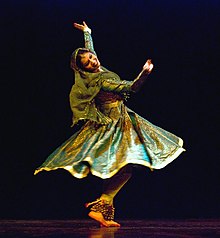
Kathak is one of the styles of Indian classical dance .
The kathak dance form originated in Northern India, in Uttar Pradesh . Its first performers were temple narrators, who illustrated the mythological episodes with gestures and dances. In the era of the Great Mogul kathak, becoming a court dance, was enriched with new elements, in particular - with complex rhythms. As a result, Kathak united the Hindu temple traditions and traditions of the Muslim court.
Kathak performed under classical Hindustani music. An orchestra usually consists of tabla , pakhawaj, sarangi , sitar and sarod . The performers are both Hindu and Muslim.
In solo performance, kathak includes small compositions of nrite , each of which is performed at a specific rhythm ( tala ). The rhythm sets the tabla, which is echoed by the rhythmic beat of the performer's feet. The dancer moves without bending her torso, making swift pirouettes that are the hallmark of the kathak. The composition can be short and be performed at a fast pace. The most important element of the kathak is the fractional stomping consisting of the most complex rhythmic patterns called tatkaras .